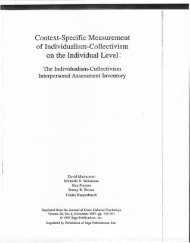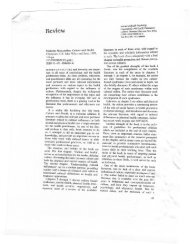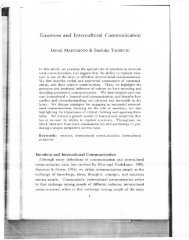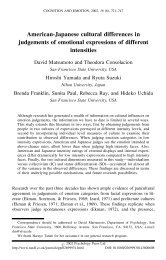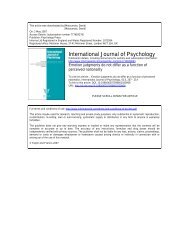(2007). Culture, context, and behavior. Journal of ... - David Matsumoto
(2007). Culture, context, and behavior. Journal of ... - David Matsumoto
(2007). Culture, context, and behavior. Journal of ... - David Matsumoto
You also want an ePaper? Increase the reach of your titles
YUMPU automatically turns print PDFs into web optimized ePapers that Google loves.
1290 <strong>Matsumoto</strong>adapting to their ecological <strong>context</strong>s in order to solve complex social<strong>and</strong> coordination problems, thereby increasing their chance <strong>of</strong>survival.Dispositional Traits <strong>and</strong> IntelligenceI further believe that part <strong>of</strong> the package <strong>of</strong> goodies evolution endowedhumans with included dispositional traits <strong>and</strong> intelligence.With regard to the former, there is evidence in the adult literature forthe universal existence <strong>of</strong> five major traits—the Five-Factor Model(Allik & McCrae, 2004; McCrae et al., 2005). But there is alsomounting evidence for the existence <strong>of</strong> other traits, as well, that gobeyond the Big Five, including subjective spirituality <strong>and</strong> traditionorientedreligiousness (Saucier, 2006), altruism versus antagonism<strong>and</strong> negative self-evaluation (Lee & Ashton, 2006), interpersonal relatedness(Cheung et al., 2001), temperamentalness <strong>and</strong> self-assurance(Church, Katigbak, & Reyes, 1998), <strong>and</strong> positive <strong>and</strong> negativevalence (Benet-Martinez & Waller, 1997). Although it is not clearwhat set <strong>of</strong> dispositional traits exists at birth, there is consensus thathumans come to the world with some set <strong>of</strong> traits that may characterizetheir basic temperament. For the purposes <strong>of</strong> this article, itmatters not exactly what traits are present at birth, nor how manyexist as adults, but only that some traits are indeed present <strong>and</strong> thathumans do not come into the world as blank slates.Finally, I assume that humans come into the world with somedegree <strong>of</strong> intelligence. Although there are many different aspects <strong>of</strong>intelligence (Sternberg, 2004), there is now strong evidence for theneurobiological correlates <strong>of</strong> fluid intelligence (Gray & Thompson,2004), which includes abilities related to reasoning <strong>and</strong> problemsolving. These are precisely the types <strong>of</strong> abilities that are directlyrelevant to adaptation <strong>and</strong> survival <strong>and</strong> may be psychometricallyindistinguishable from general intelligence (g).The Emergence <strong>of</strong> <strong>Culture</strong>CULTUREAs mentioned above, humans need to meet biological <strong>and</strong> socialneeds in order to survive, <strong>and</strong> nature endowed humans with a basictoolkit composed <strong>of</strong> abilities, dispositions, <strong>and</strong> preferences in order
<strong>Culture</strong>, Context, <strong>and</strong> Behavior 1291to meet those needs. Meeting those needs, <strong>and</strong> ultimately survival,however, is dependent on the degree to which people can adapt totheir specific environments, that is, apply their basic tools to theproblems posed to them by the specific environments in which theyexist. Different environments introduce different problems that humansmust deal with—adapt to—in order to survive.Fortunately, humans need not reinvent the wheel—create entirelynew solutions to the problems <strong>of</strong> survival posed by their environments—ineach cycle <strong>of</strong> life. Humans are inherently social animals<strong>and</strong>, as such, survive by taking advantage <strong>of</strong> the power <strong>of</strong> the group.Groups create solutions to the problems posed by their environmentsin order to address biological needs <strong>and</strong> social motives; thesesolutions are environmental adaptations <strong>and</strong> form the basis <strong>of</strong> culture.In my view, therefore, culture is the set <strong>of</strong> ways that emergeswhen a group uses the basic tools inherent in its members to addressthe problems presented by the larger ecological <strong>context</strong> in which thegroup exists in order to meet biological needs <strong>and</strong> social motives.<strong>Culture</strong> is a solution to the problem <strong>of</strong> how to survive, given theproblems in the environment, the physical <strong>and</strong> social needs that mustbe addressed, <strong>and</strong> the tools available.The Distinctiveness <strong>of</strong> Human <strong>Culture</strong>sAll animals engage in environmental adaptation in order to survive;thus, all social animals may have culture, or at least a rudimentaryform <strong>of</strong> culture consisting <strong>of</strong> social customs <strong>and</strong> adaptations(Boesch, 2003; Matsuzawa, 2001; McGrew, 2004; Whiten, Horner,& De Waal, 2005). Human cultures, however, are very different fromanimal cultures, <strong>and</strong> these differences are rooted in several uniquelyhuman cognitive abilities.One is verbal language. Humans, unlike other animals, have theunique ability to symbolize their physical <strong>and</strong> metaphysical world(Premack, 2004), to create sounds representing those symbols (morphemes),to create rules connecting those symbols into meaningfulwords (lexicon), then phrases <strong>and</strong> sentences (syntax <strong>and</strong> grammar),<strong>and</strong> to put this all together in sentences (pragmatics). Moreover,since the use <strong>of</strong> papyrus in Greece <strong>and</strong> bamboo in China, humanshave developed writing systems, so we can reduce those oral expressionsto words on paper. This article is a uniquely human product.
1292 <strong>Matsumoto</strong>Humans also uniquely have the ability to believe that other peopleare intentional agents. This ability begins at around 9 months <strong>of</strong> age(Tomasello, 1999). In one <strong>of</strong> Tomasello’s most recent studies, forexample, 18-month-old infants were presented with 10 different situationsin which an adult experimenter was having trouble achievinga goal (Warneken & Tomasello, 2006). One <strong>of</strong> these situations waswhen the experimenter accidentally dropped a marker <strong>and</strong> unsuccessfullytried to reach for it. More times than not, the infants werelikely to help the adult experimenter, even though the experimenternever asked for help or made eye contact with the infant. The factthat human infants help others achieve their goals even though thereis no direct benefit to the infant suggests that they have an underst<strong>and</strong>ing<strong>of</strong> other people’s goals <strong>and</strong> an intrinsic motivation to help.These skills were not demonstrated in chimpanzees in the samestudy. Thus, we have causal beliefs, which form the basis for attributions,a uniquely human product.Humans also have unique abilities concerning self-other knowledge.Clearly, other animals have knowledge or some conception <strong>of</strong>self. But humans are unique in that they have knowledge <strong>of</strong> self,knowledge <strong>of</strong> others, <strong>and</strong> knowledge that others know about the self(Tomasello, 1999). This knowledge is necessary in order to havemorality, another uniquely human product. The existence <strong>of</strong> selfconsciousemotions (Tangney & Fischer, 1995), such as shame, guilt,or pride, is also probably a product <strong>of</strong> this cognitive ability. Theexistence <strong>of</strong> this ability is probably why we don’t just take <strong>of</strong>f ourclothes in the middle <strong>of</strong> the street, have sex any time we want to, orhit others whom we disagree with. Other animals, however, seem notto care as much.Humans also have the unique ability to build continually uponimprovements <strong>and</strong> discoveries. When humans create something thatis useful, it is usually improved upon. This is true for computers,cars, audio music players, <strong>and</strong>, unfortunately, weapons <strong>of</strong> mass destruction<strong>and</strong> strategies for waging war. Tomasello, Kruger, <strong>and</strong>Ratner (1993) call this the ratchet effect. Like a ratchet, an improvementnever goes backward; it only goes forward <strong>and</strong> continues toimprove upon itself. The ratchet effect does not occur in other animals.Monkeys may use twigs to catch insects, but they never improveupon that tool. Humans not only make tools; they make toolsto make tools, automate the process <strong>of</strong> making tools, <strong>and</strong> mass-distributetools around the world for mass consumption.
<strong>Culture</strong>, Context, <strong>and</strong> Behavior 1293In my view these abilities differentiate human social <strong>and</strong> culturallife from that <strong>of</strong> animals in three important ways: complexity, differentiation,<strong>and</strong> institutionalization. Because humans have complex socialcognition, language, <strong>and</strong> ratcheting, human social <strong>and</strong> culturallife are much more complex than that <strong>of</strong> other animals. We aremembers <strong>of</strong> multiple groups, each having its own purpose, hierarchy,<strong>and</strong> networking system, <strong>and</strong> human cultures evolved to help us dealwith larger <strong>and</strong> more complex social groups. To deal with this complexity,humans make greater differentiations in their social lives,<strong>and</strong> institutionalize much <strong>of</strong> it. One <strong>of</strong> the functions <strong>of</strong> human cultures,therefore, is to give meaning to this social complexity. Giventhis, I define human culture as a unique meaning <strong>and</strong> informationsystem, shared by a group <strong>and</strong> transmitted across generations, thatallows the group to meet basic needs <strong>of</strong> survival, coordinate sociallyto achieve a viable existence, transmit social <strong>behavior</strong>, pursue happiness<strong>and</strong> well-being, <strong>and</strong> derive meaning from life.Human cultures exist first to enable us to meet basic needs <strong>of</strong>survival. They help us meet others to procreate <strong>and</strong> produce <strong>of</strong>fspring,put food on the table, provide shelter from the elements, <strong>and</strong>care for our daily biological essentials. But human culture is muchmore than that. It allows for complex social networks <strong>and</strong> relationships.It allows us to enhance the meaning <strong>of</strong> normal, daily activities.It allows us to pursue happiness. It allows us to be creative in music,art, drama, <strong>and</strong> work. It allows us to seek recreation <strong>and</strong> to engage insports <strong>and</strong> organize competitions, whether in the local communityLittle League or the Olympic Games. It allows us to search the sea<strong>and</strong> space. It allows us to create mathematics, an achievement noother species can claim, as well as an educational system. It allows usto go to the moon, to create a research laboratory on Antarctica, <strong>and</strong>send probes to Mars <strong>and</strong> Jupiter. Unfortunately, it also allows us towage wars, create nuclear weapons, <strong>and</strong> recruit <strong>and</strong> train terrorists.Human culture does all this by creating <strong>and</strong> maintaining complexsocial systems, institutionalizing <strong>and</strong> improving cultural practices,creating beliefs about the world, <strong>and</strong> communicating the meaningsystem to other humans <strong>and</strong> subsequent generations.Differences Among Human <strong>Culture</strong>sEach group’s set <strong>of</strong> solutions, that is culture, is different from another’sbecause <strong>of</strong> differences in the ecological <strong>context</strong>s in which each
1294 <strong>Matsumoto</strong>group exists—the physical environment, resources available, socialfactors, history, <strong>and</strong> types <strong>and</strong> sizes <strong>of</strong> their families <strong>and</strong> communities.Because different cultures exist in different ecological <strong>context</strong>s, culturesdiffer in the specific contents <strong>of</strong> their meaning <strong>and</strong> informationsystems. Cultural differences in meaning <strong>and</strong> information systems canbe observed in two broad aspects <strong>of</strong> culture—the objective or explicitelements <strong>of</strong> culture, <strong>and</strong> the subjective or implicit elements (Kroeber &Kluckhohn, 1952/1963; Tri<strong>and</strong>is, 1972). The former refer to the physicalobjects <strong>of</strong> culture—architecture, clothing, utensils, <strong>and</strong> the like,while the latter refer to the psychological aspects <strong>of</strong> culture.Research <strong>of</strong> the last two-<strong>and</strong>-a-half decades has identified a number<strong>of</strong> meaningful dimensions <strong>of</strong> cultural variability that operationalizethe subjective elements <strong>of</strong> culture. H<strong>of</strong>stede’s (1980) was first.He initially identified four dimensions—individualism versus collectivism,power distance, uncertainty avoidance, <strong>and</strong> masculinityversus femininity; more recently, he has added a fifth–long-versusshort-term orientation. Of these, individualism versus collectivismbecame the most popular <strong>and</strong> widely researched dimension (Tri<strong>and</strong>is,1994, 1995). Yet there are others. Schwartz (2004) has uncoveredseven universal value orientations; Smith, Dugan, <strong>and</strong> Trompenaars(1996) have reported two universal value orientations; House,Hanges, Javidan, Dorfman, <strong>and</strong> Gupta (2003) have reported ninevalue orientations related to leadership; Inglehart (1997) has reportedtwo attitudinal-belief-value orientations; <strong>and</strong> Bond <strong>and</strong> colleagues(2004) have reported two dimensions <strong>of</strong> social axioms (beliefs).The notion that ecological <strong>context</strong> influences culture is supportedby several lines <strong>of</strong> evidence. Country-level affluence, for instance, ishighly correlated with individualism (H<strong>of</strong>stede, 1980, 2001; Kashima& Kashima, 2003; Tri<strong>and</strong>is, 2001). Climates —average temperatures,rainfall, <strong>and</strong> the degree <strong>of</strong> extreme weather—can affect culture(Robbins, DeWalt, & Pelto, 1972); H<strong>of</strong>stede (2001) <strong>and</strong> Kashima<strong>and</strong> Kashima (2003) reported country-level correlations between thelatitude <strong>of</strong> capital cities <strong>and</strong> H<strong>of</strong>stede’s index <strong>of</strong> Individualism, whilevan de Vliert <strong>and</strong> his colleagues have demonstrated that climate isrelated to leadership <strong>behavior</strong> <strong>and</strong> volunteer work across countries(Van de Vliert, 2004, 2006; Van de Vliert, Huang, & Levine, 2004;Van de Vliert & Janssen, 2002; Van de Vliert, Schwartz, Huismans,H<strong>of</strong>stede, & Daan, 1999). Population density influences culture;members <strong>of</strong> groups with high population density, especially ifcharacterized by low resource availability (affluence), may need to
<strong>Culture</strong>, Context, <strong>and</strong> Behavior 1295cooperate more with each other in order for groups to functioneffectively. These groups may require greater rules, norms, <strong>and</strong> ritualsin order to prevent social chaos, thus encouraging greater conformity<strong>and</strong> homogeneity. Tri<strong>and</strong>is (2001) likened these effects to adimension known as tightness versus looseness <strong>of</strong> a society (Pelto,1968).Thus, ecological-level factors such as population density, climate,<strong>and</strong> affluence most likely affect cultures because different groupsneed to create different solutions for living in order to adapt to theirspecific ecological <strong>context</strong>. Groups in areas with high populationdensity, harsh weather, <strong>and</strong> low resource availability will createdifferent solutions than groups with low population density, mildweather, <strong>and</strong> high resource availability. These different solutionsproduce different cultures.Different Cultural Products<strong>Culture</strong>s influence socially transmitted <strong>behavior</strong>s, in the form <strong>of</strong> culturalpractices, as well as specific ways <strong>of</strong> underst<strong>and</strong>ing the world<strong>and</strong> themselves, in the form <strong>of</strong> cultural worldviews (<strong>Matsumoto</strong>,2006b). Cultural practices refer to the <strong>behavior</strong>al responses thatgroups produce in order to live culturally. Co-sleeping arrangementsin child rearing, for instance, is an example <strong>of</strong> a cultural practice, asare ways <strong>of</strong> dealing with bosses or subordinates at work, playingsports, or arranging flowers. Cultural worldviews refer to ideologicalbeliefs that people endorse about any domain, even about their ownculture itself. As ideological beliefs, they may have little or nothingto do with the actual cultural practices or other types <strong>of</strong> <strong>behavior</strong>sthat occur in real life. Cultural worldviews exist because humanshave a universal need for explanations <strong>of</strong> their <strong>behavior</strong>s <strong>and</strong> causalattribution, as well as for self- <strong>and</strong> group enhancement. As we willdiscuss below, cultural practices are rather flexible <strong>and</strong> adapted foreach family <strong>and</strong> individual. Cultural worldviews, however, tend to berather stereotypic, harbored to some degree by most in a culture.CULTURE AND SITUATIONAL CONTEXTAs inherently social animals, humans live in a succession <strong>of</strong> multiple,different, situational <strong>context</strong>s. Consistent with my definition <strong>of</strong> cultureabove, one <strong>of</strong> the functions <strong>of</strong> human cultures is to ascribe
1296 <strong>Matsumoto</strong>meaning to these situational <strong>context</strong>s. Of course there are manydifferent aspects <strong>of</strong> situational <strong>context</strong>, including time, place, interactants,the content <strong>of</strong> activities or conversations, the reasons whythe interactions are occurring in the first place, <strong>and</strong> the possibility <strong>of</strong>any future interactions between the same interactants. All <strong>of</strong> thesefactors, <strong>and</strong> others, combine to produce the unique situational <strong>context</strong>sin which we live our lives. In this article, I focus on two <strong>of</strong> theseaspects that I believe are major components <strong>of</strong> situational <strong>context</strong>:interactants <strong>and</strong> settings.InteractantsBecause humans are social animals, <strong>and</strong> because human social life iscomplex, we need to interact with many different types <strong>of</strong> others.Survival requires social coordination, <strong>and</strong> human cultures ascribemeaning to interactants to aid in this coordination. Without suchmeaning there would be social chaos, which would ultimately bedetrimental to both individuals <strong>and</strong> groups. At least two studies haveexamined what these meanings may be. Marwell <strong>and</strong> Hage (1970),for instance, suggested the existence <strong>of</strong> three dimensions to describethe nature <strong>of</strong> role-dyads: intimacy, visibility, <strong>and</strong> regulation. McAuley,Bond, <strong>and</strong> Kashima (2002) obtained ratings <strong>of</strong> role-dyads inAustralia <strong>and</strong> Hong Kong <strong>and</strong> demonstrated the existence <strong>of</strong> fourdimensions used by persons <strong>of</strong> both cultures to organize these relationships:complexity, equality, adversarialness, <strong>and</strong> containment.In my view, there are two major ways in which human culturesascribe meaning to others in order to aid social coordination: (1) therelationship between the individual <strong>and</strong> the group <strong>and</strong> (2) the establishment<strong>and</strong> maintenance <strong>of</strong> hierarchies. With regard to the former,all human societies make distinctions between ingroups <strong>and</strong> outgroups(Brewer & Kramer, 1985; Messick & Mackie, 1989; Tajfel,1982). Ingroups are afforded favored status by individuals <strong>and</strong> fostercoordination, conformity, <strong>and</strong> cooperation. Ingroups function effectivelyto aid in the accomplishment <strong>of</strong> goals <strong>and</strong> activities that ultimatelyaid in the survival <strong>of</strong> the group. Outgroup members canthreaten the ability <strong>of</strong> ingroups to achieve their goals <strong>and</strong>, thus, theirsurvival. Self-ingroup relationships, therefore, are inherently differentfrom self-outgroup relationships, <strong>and</strong> in all societies, enculturationinvolves learning who are ingroups <strong>and</strong> who are not, <strong>and</strong> thespecific meanings associated with them.
<strong>Culture</strong>, Context, <strong>and</strong> Behavior 1297With regard to the latter, all groups require some degree <strong>of</strong>hierarchy in order to function effectively. A group with no leadersis just as dysfunctional as a group with only leaders. Thus,social roles within hierarchies need to be clearly defined in orderfor groups to function effectively, <strong>and</strong> groups <strong>and</strong> individuals spendmuch time <strong>and</strong> energy on establishing lines <strong>of</strong> authority—dominancein a hierarchy—in order to clarify these social roles. Status<strong>and</strong> power are typically conferred to those higher in a dominancehierarchy.And while all people <strong>of</strong> all cultures make great social distinctionsamong the different interactants in their lives, there are differences inthe degree to which different cultures ascribe their meaning systemsto interactants. For example, while the distinction between ingroups<strong>and</strong> outgroups is universal, cultures differ in the specific meanings <strong>of</strong>self-ingroup <strong>and</strong> self-outgroup relationships (Tri<strong>and</strong>is, Bontempo,et al., 1988). How cultural groups differ in this regard is characterizedby the concept <strong>of</strong> individualism versus collectivism (H<strong>of</strong>stede,2001) or autonomy versus embeddedness (Schwartz, 2004), both <strong>of</strong>which are aspects <strong>of</strong> subjective culture mentioned earlier. Individualistic,autonomous cultures may foster the development <strong>of</strong> moreingroups, <strong>and</strong> their members are not attached as much to any singleingroup. Collectivistic, embedded cultures, however, foster the development<strong>of</strong> fewer ingroups, but their commitment to ingroups isgreater than in individualistic cultures. Thus, self-ingroup <strong>and</strong> selfoutgrouprelationships differ in individualistic <strong>and</strong> collectivistic culturesin the degree <strong>of</strong> harmony, cohesion, cooperation, <strong>and</strong> conformitybetween the self <strong>and</strong> the group. Collectivistic cultures foster agreater degree <strong>of</strong> conformity within their ingroups, <strong>and</strong> sanctionsexist for nonconformity. A high degree <strong>of</strong> conformity ensures thatindividuals are identified <strong>and</strong> bonded with their ingroups, allowinggroups to function <strong>and</strong> for group needs to supersede individual ones.Subjugating personal goals in favor <strong>of</strong> the group is a primary feature<strong>of</strong> collectivism. Individualistic cultures foster less conformity withingroups because they do not rely as much on identification withgroups for the effective functioning <strong>of</strong> either the groups or the individualsfor survival.<strong>Culture</strong>s may also differ in the nature <strong>of</strong> hierarchical differences aswell, <strong>and</strong> these cultural differences are captured by the concept <strong>of</strong>egalitarian versus hierarchical cultures (Schwartz, 2004) or PowerDistance (H<strong>of</strong>stede, 2001). Hierarchical, high Power Distance
1298 <strong>Matsumoto</strong>cultures may tend to utilize fixed attributes <strong>of</strong> individuals, such asage, seniority, or sex as criteria to afford status. In egalitarian, lowPower Distance cultures, educational degrees, performance, or abilitymay be used as such criteria. Hierarchical, high Power Distancecultures should foster a greater differentiation according to status,while egalitarian, low Power Distance cultures should foster less(<strong>Matsumoto</strong>, 2006c).McAuley et al.’s (2002) study is illustrative <strong>of</strong> cultural differencesin the meaning <strong>of</strong> social interactants. In their study, participants inHong Kong <strong>and</strong> Australia rated a number <strong>of</strong> role dyads on 20 itemsthat tapped objective, <strong>context</strong>ual characteristics <strong>of</strong> the dyads <strong>and</strong> notjudgments <strong>of</strong> a psychological nature. As mentioned above, four<strong>context</strong>ual dimensions were identified—complexity, equality, adversarialness,<strong>and</strong> containment—<strong>and</strong> these were similar acrossboth cultures. Yet the two cultures differed in the placement <strong>of</strong> specificrole dyads on these dimensions. For instance, some dyads thatwere high on adversarialness, such as political opponents, personalenemies, or business rivals, were rated more equal among HongKong Chinese than Australians. Also, many family members wererated more unequal in Hong Kong than in Australia.The SettingDifferent settings are associated with different cultural meanings,<strong>and</strong> these differences influence <strong>behavior</strong>. Being in public, for example,is different than being in private, <strong>and</strong> individuals regulate their<strong>behavior</strong>s much more in public than in private. The regulating effect<strong>of</strong> public settings may be due to the fact that being in public is associatedwith the cognitive representation that others have knowledge<strong>of</strong> oneself <strong>and</strong> can make causal attributions <strong>and</strong> judgmentsabout oneself (Baumeister, 2005; Tomasello, 1999). Thus, peoplewatch what they do because they are concerned about how they willbe judged by others. This concern is also likely activated in the mirroreffect—the fact that individuals <strong>of</strong>ten regulate various aspects <strong>of</strong>their <strong>behavior</strong> when they see themselves as others see them (Mor &Winquist, 2002).What exactly are the cultural meanings associated with setting? Infact, there has been very little research in psychology on this topic,despite the widespread acknowledgment <strong>of</strong> the importance <strong>of</strong> settingas a component <strong>of</strong> situational <strong>context</strong>. The only study I know
<strong>Culture</strong>, Context, <strong>and</strong> Behavior 1299<strong>of</strong> that actually attempted to define the meaning <strong>of</strong> setting wasAltman’s (1975), which differentiated between primary <strong>and</strong> secondaryprivate settings—the former those that people feel belong tothem exclusively <strong>and</strong> are central to their identities, the latter beingpublic settings that are used with such regularity that one develops aproprietary orientation toward them.In my view, the cultural meaning <strong>of</strong> settings revolves around threecomponents: beliefs, uncertainty, <strong>and</strong> anxiety. First <strong>of</strong> all, settingsare associated with a set <strong>of</strong> beliefs about the degree to which othersmay be watching or judging oneself <strong>and</strong> others associated with oneself(e.g., one’s family, friends, others <strong>of</strong> the same ethnic group, etc.).These may also include beliefs concerning the degree to which thejudgments <strong>of</strong> others have potentially positive or negative consequencesfor oneself or others as well as consequences to future relationshipswith oneself or others.Settings are also associated with some degree <strong>of</strong> uncertainty,especially concerning one’s knowledge about how others maythink, feel, or act. And because <strong>of</strong> this uncertainty, different settingsare associated with different degrees <strong>of</strong> anxiety about how othersmay be. Uncertainty <strong>and</strong> ambiguity inherent to settings, <strong>and</strong> theanxiety associated with them, are likely to produce regulatoryeffects on <strong>behavior</strong>. Guerin (1986), for instance, suggested that inhibitory<strong>context</strong>s, in which the emotions, <strong>behavior</strong>s, cognitions,<strong>and</strong> intentions <strong>of</strong> others are uncertain, influence individuals to bemore cautious in their <strong>behavior</strong>s. Inhibitory <strong>context</strong>s are generallythose in which one’s <strong>behavior</strong>s are under the watchful eyes <strong>of</strong>unknown or less familiar others, <strong>and</strong> such <strong>context</strong>s produce increasedconformity in <strong>behavior</strong>s to cultural norms because <strong>of</strong> theobservation.Thus, settings that are associated with strong beliefs that othersmay be judging oneself, that those beliefs have potentially strongconsequences for oneself <strong>and</strong> others, <strong>and</strong> that are associated withhigh degrees <strong>of</strong> uncertainty <strong>and</strong> anxiety are likely to produce a highdegree <strong>of</strong> regulatory effects on <strong>behavior</strong>. Settings associated withstrong beliefs that one’s <strong>behavior</strong> is not judged, that judgments <strong>of</strong>others have no consequences for oneself, <strong>and</strong>/or in which there islittle ambiguity <strong>of</strong> the actions <strong>of</strong> others are likely to produce muchless regulatory effects on <strong>behavior</strong>. Thus, being in a crowdedcompany conference room with one’s prospective employers isa very different setting than being at home, <strong>and</strong>, because <strong>of</strong> these
1300 <strong>Matsumoto</strong>psychological differences in the meaning <strong>of</strong> these settings, producesdifferent effects on <strong>behavior</strong>.Human cultures help ascribe these meanings to settings, <strong>and</strong>different cultures ascribe different meanings to the same setting.We do not know, however, the degree to which setting differencesdiffer across cultures. They should. Future research is needed to examinethe degree to which the psychological meaning <strong>of</strong> settingdiffers across cultures.The Emergence <strong>of</strong> Social RolesThus, human cultures prescribe meanings to situational <strong>context</strong>s,<strong>and</strong> because human social life is complex, the myriad <strong>of</strong> situational<strong>context</strong>s in which individuals exist is associated with a myriad <strong>of</strong>cultural meanings. The meanings <strong>of</strong> the various situational <strong>context</strong>screate expectations for the players in <strong>context</strong> in terms <strong>of</strong> normative<strong>behavior</strong>s, which are the <strong>behavior</strong>s that each culture expects itsmembers to engage in given the specific situational <strong>context</strong> in whichthey are in order to achieve the goal <strong>of</strong> living in a culturally appropriatefashion. The expectations concerning normative <strong>behavior</strong>s aresummarized for each individual member <strong>of</strong> a culture in a social role.Social roles are like scripts in a play (see G<strong>of</strong>fman, 1959) sincethey delineate the types <strong>of</strong> <strong>behavior</strong>s that are expected in the specificsituational <strong>context</strong> based on the specific meanings ascribed to that<strong>context</strong>. Because cultures define the meaning <strong>of</strong> the situational <strong>context</strong>,the scripts associated with the <strong>context</strong>s are culturally dependent.Thus, cultural differences in the meaning <strong>of</strong> specific situational<strong>context</strong>s suggest that there are cultural differences in the specific roleexpectations associated with different situations across cultures.While situational <strong>context</strong> provides the general scripts <strong>of</strong> <strong>behavior</strong>,cultures adjust those scripts according to their <strong>context</strong>-specificframeworks.SITUATIONAL CONTEXTS AND PERSONALITYThe Interaction Between Situational Contexts <strong>and</strong> PersonalityMy underst<strong>and</strong>ing <strong>of</strong> the interaction between culture, via situational<strong>context</strong>s <strong>and</strong> social roles, <strong>and</strong> personality is informed by Roberts <strong>and</strong>
<strong>Culture</strong>, Context, <strong>and</strong> Behavior 1301colleagues’ Personality <strong>and</strong> Role Identity Structural Model (PRISM:Wood & Roberts, 2006). The PRISM model posits a personalityhierarchy with multiple levels, including the existence <strong>of</strong> underlyingdispositional traits, role identities, aggregated role experiences, <strong>and</strong>single role experiences.Complementing this model, I assume that individuals respond toculturally based social roles described above by adopting role identities,which require them adapt to the specific situations correspondingto the social roles. As individuals engage with multiplesituational <strong>context</strong>s with multiple, culturally prescribed social roles,individuals situationally adapt to these, producing alterations intheir underlying dispositional traits. Thus, while a ‘‘core’’ set <strong>of</strong> underlyingdispositional traits may exist, humans adapt to specific situational<strong>context</strong>s by tapping into this underlying dispositional traitresource pool in order to perform the culturally prescribed socialroles.Repeated role performances—the thoughts, feelings, <strong>and</strong> <strong>behavior</strong>sthat occur in real life across single role experiences—produce ahistory that comprises aggregate role experiences (Wood & Roberts,2006). These experiences, in turn, form the basis <strong>of</strong> other importantaspects <strong>of</strong> personality, including narratives, values, <strong>and</strong> generalmotives (Roberts, 2006). Dispositional traits that humans bringwith them into the world may be modified <strong>and</strong> adapted throughoutdevelopment <strong>and</strong> the life span via interactions with the environment.Over time, dipping into this resource pool in order to adapt tovarious situational <strong>context</strong>s may serve as the impetus for changes tothe pool itself, which may account for changes in consistency <strong>and</strong>mean levels <strong>of</strong> the dispositional traits observed in previous studies(Roberts & DelVecchio, 2000; Roberts, Walton, & Viechtbauer,2006).Individual Differences in Role Performance: The Flexibility <strong>of</strong> <strong>Culture</strong>Even though there may be within-culture consensus on the contents<strong>of</strong> culturally prescribed social roles <strong>and</strong> normative <strong>behavior</strong>, themodel proposed above leaves considerable room for individualdifferences. For example, situational <strong>context</strong>s may have differentmeanings because <strong>of</strong> individual differences in how people conceive<strong>and</strong> underst<strong>and</strong> their culturally based social role expectations <strong>and</strong>the degree to which they accept or reject such expectations. While
1302 <strong>Matsumoto</strong>studies <strong>of</strong> cultural differences generally focus on between-groupdifferences in means (e.g., in values, beliefs, or <strong>behavior</strong>s), recentstudies <strong>of</strong> within-culture variation indicate that such intraculturalvariation tends to be relatively large (compared to between-culturedifferences; Au, 1999, 2000). Moreover, the degree <strong>of</strong> intraculturalvariation itself appears to be related to culture. Although researchexamining cultural differences in intracultural variation is just beginning,there is indirect evidence that is relevant. Bond <strong>and</strong> Smith(1996), for instance, conducted a meta-analysis <strong>of</strong> studies examiningthe effects <strong>of</strong> conformity across studies involving the types <strong>of</strong> tasksoriginally used by Asch. Analyzing 133 studies conducted in 17different countries, they found that the magnitude <strong>of</strong> the effect <strong>of</strong>conformity was very large in some countries <strong>and</strong> very small in others,with a mean effect <strong>of</strong> moderate value. Conformity was higher whenthe majority that tried to influence the conforming participant waslarger, when there was a greater proportion <strong>of</strong> female participants,when the majority did not consist <strong>of</strong> outgroup members, <strong>and</strong> whenthe stimuli were more ambiguous. Conformity was also higher incollectivistic cultures than in individualistic ones. In Milgram’s(1974) study, about 65% <strong>of</strong> the participants obeyed the instructions<strong>of</strong> the experimenter <strong>and</strong> administered a high level <strong>of</strong> shock to theconfederate. Smith <strong>and</strong> Bond (1999) reviewed nine other studies thatused the Milgram paradigm, conducted in the United States <strong>and</strong>eight other countries. The results <strong>of</strong> these studies indicated a broadrange in the percentage <strong>of</strong> participants obeying the experimenter,ranging from a low <strong>of</strong> 16% among female students in Australia to ahigh <strong>of</strong> 92% in the Netherl<strong>and</strong>s.Individual differences also occur because specific situational <strong>context</strong>sare <strong>of</strong>ten different for different individuals, regardless <strong>of</strong> similaritiesin the prescribed social roles. On the one h<strong>and</strong>, cultureprescribes limits <strong>and</strong> broad guidelines for acceptable personal <strong>and</strong>social <strong>behavior</strong>. On the other h<strong>and</strong>, culture allows a broad range <strong>of</strong>freedom. It does so by providing a number <strong>of</strong> acceptable social rolesfor individuals to occupy <strong>and</strong> provides minimum prescriptions fortheir instantiation. For example, there may be broad differences inchild-rearing practices across different cultures, with some culturesencouraging infants to sleep by themselves through the night, whileothers encourage infants to co-sleep with their parents until earlychildhood. Yet every family does this differently; when do these culturalpractices start <strong>and</strong> stop? How faithfully does the family practice
<strong>Culture</strong>, Context, <strong>and</strong> Behavior 1303it? Do all children do the same, or do some differ? What happenswhen the child or parent is sick? While a culture may prescribe acertain general guideline about this aspect <strong>of</strong> child rearing, theguideline is put into practice in a myriad <strong>of</strong> different ways, reflectingcommunal, familial, individual, <strong>and</strong> situational differences withinthe culture.Individual differences may also occur because <strong>of</strong> individual differencesin the amount <strong>and</strong> type <strong>of</strong> dispositional traits individuals comeinto the world with. As mentioned previously, although there is disagreementabout exactly which traits are present at birth, there isconsensus that individuals do come into the world with some traitsthat have a genetic component <strong>and</strong> that there are individual differencesin these. These individual differences can influence the emergence<strong>of</strong> role identities during interactions with the environment <strong>and</strong>social roles.<strong>Culture</strong>s represent a set <strong>of</strong> human-made inventions that help individualsthe world over deal with the same basic life issues. Becausedifferent parts <strong>of</strong> the world present those same problems in differentways, cultural solutions are different for different ecological <strong>context</strong>s.<strong>Culture</strong> provides meaning <strong>and</strong> information systems that arespecific <strong>and</strong> unique to the environment in which it exists. Yet cultureis flexible, <strong>and</strong> the solutions provided to its members are broadguidelines with wide ranges <strong>of</strong> acceptable tolerances. While culturesprovide the basic guidelines for <strong>behavior</strong>, there is a wide range <strong>of</strong>acceptable conduct within these cultural guidelines. <strong>Culture</strong>s alsodefine the meaning <strong>of</strong> specific situations <strong>and</strong> specify the expectations<strong>of</strong> the players like a script. Yet there is wide individual variation inhow individual members conceptualize their roles, <strong>and</strong> accept or not,conform or not, to those roles. These notions are, in fact, consonantwith notions <strong>of</strong> the flexibility <strong>of</strong> culture (Linton, 1945). The result is awide range <strong>of</strong> individual differences even within any cultural framework.In this perspective, culture provides ready-made, pretestedsolutions to many <strong>of</strong> life’s problems (Allport, 1936). Individuals,according to their underlying <strong>and</strong> possibly innate temperaments <strong>and</strong>personalities, select from a tolerable range <strong>of</strong> acceptable <strong>behavior</strong>s<strong>and</strong> practices allowed by culture to adopt features that best fit theirown lifestyle. Many cultural practices are internalized by some sothat some members <strong>of</strong> a culture are quite conformist; others, however,may rebel <strong>and</strong> be total cultural misfits. Most <strong>of</strong> us fall somewherein between (Allport, 1936).
1304 <strong>Matsumoto</strong>SITUATIONAL CONTEXT MODERATES THE RELATIVECONTRIBUTIONS OF UNIVERSAL PSYCHOLOGICALPROCESSES, CULTURE, AND PERSONALITYThe model I have outlined thus far is summarized in Figure 1 <strong>and</strong>suggests that what people think, feel, <strong>and</strong> do can be construed as roleperformances. That is, mental processes <strong>and</strong> <strong>behavior</strong>s, even in thelaboratory (or perhaps, especially in the laboratory) do not occurin a vacuum; rather, they occur in a particular situational <strong>context</strong>with a personal <strong>and</strong> evolutionary history, aggregated experiences,<strong>and</strong> possible future consequences. Mental processes <strong>and</strong> <strong>behavior</strong>sthat occur under such conditions are, in fact, an individualperformance.The model further suggests that the relative contributions <strong>of</strong> basichuman nature (via universal psychological processes), culture (viasocial roles), <strong>and</strong> personality (via individual differences in role identities)in accounting for role performance <strong>behavior</strong> are moderated bythe situational <strong>context</strong> in which the individual is in <strong>and</strong> <strong>behavior</strong> isoccurring. Thus, some situations are likely to evoke similar responsesfrom all individuals regardless <strong>of</strong> personality or culture. Some areFigure 1Situational <strong>context</strong> moderates the relative contributions <strong>of</strong> basichuman nature, culture, <strong>and</strong> personality to mental processes <strong>and</strong><strong>behavior</strong>s.
<strong>Culture</strong>, Context, <strong>and</strong> Behavior 1305likely to evoke responses that demonstrate cultural differences. Andsome are likely to demonstrate mainly individual differences. Thismeans that in some situational <strong>context</strong>s, <strong>behavior</strong> can be mainly determinedby universal psychological processes; in others, mainly bypersonality; <strong>and</strong> yet in others, mainly by culture.Further, this model also suggests that the relative contributions <strong>of</strong>the three sources <strong>of</strong> <strong>behavior</strong> may be different for different dependentvariables. There should be a difference in the relative contributions<strong>of</strong> basic human nature, culture, <strong>and</strong> personality inaccounting for actual <strong>behavior</strong>s related to one’s immediate welfare,as opposed to beliefs about hypothetical situations that have little todo with one’s welfare. Actual <strong>behavior</strong>s may be more influenced bybasic human nature <strong>and</strong> personality, while self-reports <strong>of</strong> <strong>behavior</strong>,or <strong>of</strong> attitudes <strong>and</strong> values, may be more influenced by culture.EVIDENCE FROM STUDIES OF EMOTIONLet me discuss findings from the area <strong>of</strong> study I know best—emotion—to exemplify the utility <strong>of</strong> the model. When strong emotionsare elicited in situations in which individuals are alone <strong>and</strong> freeto respond without social constraint, all individuals, regardless <strong>of</strong>culture or sex, express emotions in their faces in the same ways (Ekman,1972; <strong>Matsumoto</strong> & Willingham, 2006). These are situationsthat allow for the influence <strong>of</strong> a universal facial affect program todirectly <strong>and</strong> primarily influence <strong>behavior</strong>. Yet when these same individualsare in situations that place social constraints on them, theyalter their expressions to be consonant with culturally accepted norms(Ekman, 1972; <strong>Matsumoto</strong> & Kupperbusch, 2001; <strong>Matsumoto</strong> &Willingham, 2006). These are situations that allow for a stronger influence<strong>of</strong> culture to override basic human nature, according to amechanism known as cultural display rules (Ekman & Friesen, 1969).Examinations <strong>of</strong> cultural display rules across a wide range <strong>of</strong> situational<strong>context</strong>s <strong>and</strong> cultures also provide evidence for the modelpresented in Figure 1. In our 30-country study <strong>of</strong> display rules(<strong>Matsumoto</strong> et al., 2005), participants gave the highest expressivityratings when alone, followed by when with family <strong>and</strong> close friendsin private, family <strong>and</strong> close friends in public, acquaintances inprivate, alone in public, acquaintances in public, pr<strong>of</strong>essors in private,<strong>and</strong> pr<strong>of</strong>essors in public. These differences reflected universal
1306 <strong>Matsumoto</strong>differences in expressivity norms as a function <strong>of</strong> situational <strong>context</strong>.Correlations between each country’s means on expressivity in each<strong>of</strong> the situational <strong>context</strong>s <strong>and</strong> H<strong>of</strong>stede’s (2001) five cultural dimensionsindicated that the cultural dimensions were strongly correlatedwith the country means in the ‘‘alone’’ <strong>and</strong> ‘‘family <strong>and</strong> closefriends in private’’ situations, somewhat less correlated in the ‘‘family<strong>and</strong> close friends in public’’ <strong>and</strong> ‘‘acquaintances in private’’ situations,<strong>and</strong> not correlated at all in the remaining situations. Thesedata suggested that cultural influences on expressivity norms arestrongest for the former situations but weaker for the latter, indicatingthat situational <strong>context</strong>s allow for cultural influences to occurin some situations but not others. Indices <strong>of</strong> interindividual variabilitywere also computed; these represent individual differences inexpressivity norms. This variance was largest in the ‘‘alone in private<strong>and</strong> in public’’ situations, suggesting that these situations allowed forthe largest individual differences to emerge; they were significantlysmaller in the other conditions, suggesting that, while individualdifferences existed in all <strong>context</strong>s, some situational <strong>context</strong>s allowedfor individual differences to emerge more than others.Studies on emotion recognition <strong>of</strong>fer another line <strong>of</strong> evidence forthe influence <strong>of</strong> situational <strong>context</strong>. Many studies demonstrate thatwhen universal facial expressions <strong>of</strong> emotion are shown by themselvesto observers who are asked to judge what emotion is beingportrayed, there is high, universal agreement about the emotionsportrayed (<strong>Matsumoto</strong>, 2001). These findings demonstrate the existence<strong>of</strong> a universal psychological process to recognize emotions. Ina recent study, we (<strong>Matsumoto</strong> & Yamada, 2006) showed judges theuniversal faces along with vignettes that were pretested to be associatedwith emotions at roughly the same accuracy rates as the faces.The face-vignette combinations were either congruent (i.e., same intendedemotion in the face <strong>and</strong> vignette) or incongruent, <strong>and</strong> judgeswere asked what the actors were feeling. For congruent face-vignettecombinations, there were no cultural differences in the judgments,<strong>and</strong> agreement rates <strong>of</strong> the intended emotions were higher than eitherface or vignette alone (88.7% for U.S., 95% for Japan). Whenface-vignette combinations were incongruent, however, recognitionrates varied. Americans were more likely to believe that the actorwas feeling an emotion congruent more with the face (51%) comparedto the vignette (15%), while Japanese were evenly split intheir judgments (34% each for face <strong>and</strong> vignette). These cultural
<strong>Culture</strong>, Context, <strong>and</strong> Behavior 1307differences in judgments were statistically significant <strong>and</strong> indicatedthat the situational <strong>context</strong> manipulation altered the judgment processfrom one that was primarily based on a universal recognitionability (congruent face <strong>and</strong> vignette) to one that was influenced byculture (incongruent pairings). Recent neuroscience research has begunto examine how the brain may function differently when facesare paired with such congruent <strong>and</strong> incongruent <strong>context</strong> information(Righart & de Gelder, in press).Differences in findings from research on self-reported emotionalexperiences can also be reconciled with the model presented in Figure1. When phenomenologically based self-reports <strong>of</strong> emotionalexperience are assessed, especially concerning the intensity <strong>of</strong> experience,verbal <strong>and</strong> nonverbal reactions, <strong>and</strong> physiological sensations,there are relatively small cultural differences (Breugelmans et al.,2005; Scherer & Wallbott, 1994). Also, different phenomenologicalexperiences are reliably related to each other, suggesting the existence<strong>of</strong> coherence among emotion response systems, <strong>and</strong> this coherenceis relatively unrelated to culture (<strong>Matsumoto</strong>, Nezlek, &Koopmann, <strong>2007</strong>). These findings suggest an underlying universalpsychological process related to emotion. When, however, appraisalsrelated to emotion elicitation are assessed (Scherer, 1997), or whenbeliefs, concerns, <strong>and</strong> social meanings <strong>of</strong> emotions are assessed(Mesquita, 2001; Mesquita & Karasawa, 2002), reliable culturaldifferences emerge. This makes sense because these aspects <strong>of</strong> emotionare more heavily influenced by social <strong>and</strong> cultural construction,whereas the basic emotion program is biological <strong>and</strong> universal.There is also a rich literature documenting the relationship betweenpersonality <strong>and</strong> emotion (Keltner, 1996; Malatesta-Magai, 1990).Much <strong>of</strong> it suggests that emotions are central to the structure <strong>of</strong> personality<strong>and</strong> how it forms. A large portion <strong>of</strong> this line <strong>of</strong> study hasfocused on the organization <strong>of</strong> emotion words as reflective <strong>of</strong> personality(Shaver, Murdaya, & Fraley, 2001; Shaver, Schwartz, Kirson, &O’Connor, 1987; Shaver, Wu, & Schwartz, 1992) <strong>and</strong> on the structure<strong>of</strong> affect (Feldman Barrett & Russell, 1999; Watson & Tellegen, 1985).Individual differences in attentional <strong>and</strong> perceptual processes in thebrain linked to the regulation <strong>of</strong> <strong>behavior</strong> have been linked to a number<strong>of</strong> emotion processes as well (Derryberry & Reed, 2003), as haveindividual differences in reactivity <strong>and</strong> coping (Krohne, 2003).Also germane to this article is previous work linking specific personalitytraits to emotions. For example, one <strong>of</strong> the most consistent
1308 Matsumot<strong>of</strong>indings in the literature is that Extraversion is correlated with boththe experience (Schimmack, Radhakrishnan, Oishi, & Dzokoto,2002) <strong>and</strong> expression <strong>of</strong> positive emotions (Costa & McCrae, 1980;Emmons & Diener, 1985, 1986; Pavot, Diener, & Fujita, 1990; Ruch,1993). Neuroticism has been correlated with the experience <strong>of</strong> negativeemotions (Schimmack et al., 2002). Individuals low on Agreeablenessmay be prone to more anger; this notion is supported byChesney et al.’s (1990) findings that facial glares may be related tohostility, <strong>and</strong> by Keltner, M<strong>of</strong>fitt, <strong>and</strong> Stouthamer-Loeber’s (1995)findings that adolescents who externalized displayed more anger,while adolescents who internalized showed more fear. Also, twostudies have shown that Openness is positively correlated with theability to recognize emotions in faces (<strong>Matsumoto</strong> et al., 2000; Terracciano,Merritt, Zonderman, & Evans, 2003).Collectively, the literature suggests that there is a biologicallybased emotion program that is genetically encoded in all individuals.This program forms the basis <strong>of</strong> a universal psychological processrelated to emotion <strong>and</strong> is a part <strong>of</strong> basic human nature. There arelikely individual differences in the arousability <strong>of</strong> this system—somepeople are more easily aroused than others—in the intensity <strong>of</strong> response<strong>and</strong> in the types <strong>of</strong> emotions that are more easily aroused.These individual differences form the basis <strong>of</strong> personality influenceson emotion. Aggregate differences in personality can produce culture-levelmean differences in emotion responding that appear cultural,<strong>and</strong> cultures influence the meaning <strong>of</strong> specific situations thatelicit emotions <strong>and</strong> the meaning <strong>of</strong> emotions to oneself <strong>and</strong> othersonce elicited. These form the basis <strong>of</strong> cultural influences on emotion.Given this state <strong>of</strong> affairs, any particular study may elicit universalresponding, individual differences in responding, or cultural differences,depending on the specific aspect <strong>of</strong> emotion being studied <strong>and</strong>the specific situational <strong>context</strong> in which it is studied.CONCLUSIONThe model presented in this article is consonant with Kluckhohn,Murray, <strong>and</strong> Schneider’s (1953) notion over a half century ago thatevery person is in certain respects like all others, like someothers, <strong>and</strong> like no others (p. 53). The model here suggests that,broadly speaking, much human <strong>behavior</strong> can be accounted for by
<strong>Culture</strong>, Context, <strong>and</strong> Behavior 1309incorporating what is true for all humans (basic human nature/universalpsychological processes), what is true for some humans <strong>of</strong> thesame group (cultural influences/situational <strong>context</strong>/social roles), <strong>and</strong>what is unique to the person (personality/role identities/experiences).If we use a multilevel model to represent these sources to explain<strong>behavior</strong>, we can conceptualize individual <strong>behavior</strong>s <strong>and</strong> mentalprocesses as role performances that are dependent on a host <strong>of</strong> personalityprocesses at Level 1 (role identities, aggregate role experiences,narratives, values, motives), with culture (situational meaning,social roles, norms) <strong>and</strong> basic human nature (universal psychologicalprocesses, dispositional traits, intelligence) at Level 2, <strong>and</strong> ecologicalvariables (geography, climate, resource availability) at Level 3.One <strong>of</strong> the goals <strong>of</strong> research in psychology is to identify the relativecontributions <strong>of</strong> each <strong>of</strong> these sources in a complex, multilevelmodel. Unfortunately, most cross-cultural researchers primarilyconsider Level 2 effects—<strong>and</strong> sometimes Level 3—but usually excludeLevel 1. Identifying the effects <strong>of</strong> culture but ignoring the potentialeffects <strong>of</strong> other sources ignores the possibility that culturaldifferences mask the effects <strong>of</strong> the other sources. For example,<strong>Matsumoto</strong> (2006a) recently conducted a study in which he demonstratedAmerican–Japanese country differences on emotion regulation,with Americans demonstrating higher tendencies to reappraiseemotion-eliciting events <strong>and</strong> Japanese demonstrating higher tendenciesto suppress their emotional reactions. While many cultural theoristscould take these findings <strong>and</strong> develop cultural theories toexplain why Americans reappraise more <strong>and</strong> suppress less thanthe Japanese, such cultural theories would negate the possibilitythat individual differences in dispositional traits accounted for thosecountry-level differences. Indeed, this study also included anassessment <strong>of</strong> the Five-Factor Model <strong>of</strong> personality, <strong>and</strong> statisticalanalyses indicated that Extraversion, Neuroticism, <strong>and</strong> Conscientiousnessfully accounted for the observed between-country differencesin emotion regulation. These findings suggested that the source<strong>of</strong> the observed country differences was not cultural <strong>and</strong> instead layin dispositional traits. Future research, <strong>and</strong> especially cross-culturalresearch, needs to consider strongly the incorporation <strong>of</strong> personalityassessments in their designs in order to demonstrate empirically thatany observed differences are truly ‘‘cultural’’ or not.The perspective I have described also provides a more nuancedview <strong>of</strong> how cultures <strong>and</strong> self-construals may influence <strong>behavior</strong>. The
1310 <strong>Matsumoto</strong>dominant model in the field suggests that certain cultures are associatedwith certain types <strong>of</strong> self-construals, for example, that individualisticcultures produce independent self-construals, thatcollectivistic cultures produce interdependent self-construals, <strong>and</strong>that these different self-construals, in turn, produce different types <strong>of</strong><strong>behavior</strong>s (Markus & Kitayama, 1991). This viewpoint, however,essentially substitutes culture for a personality-type variable to explaingroup differences. Individuals in all cultures, however, probablyhave multiple senses <strong>of</strong> self, such as the private, public, <strong>and</strong>collective self (Tri<strong>and</strong>is, 1989). Moreover, the nature <strong>of</strong> self-construalscan differ, depending on how they are assessed in questionnaires(<strong>Matsumoto</strong>, Weissman, Preston, Brown, & Kupperbusch,1997; Rhee, Uleman, & Lee, 1996; Uleman, Rhee, Bardoliwalla,Semin, & Toyama, 2000); in experiments, different culturally basedself-construals can be accessed within the same individuals dependingon how they are primed (Gardner, Gabriel, & Lee, 1999; Trafimow,Silverman, Fan, & Law, 1997; Trafimow, Tri<strong>and</strong>is, & Goto,1991; Ybarra & Trafimow, 1988). This suggests a more complex view<strong>of</strong> the relationship between culture, self, <strong>and</strong> <strong>behavior</strong>, based on themodel presented here, one in which individuals have multiple senses<strong>of</strong> self, some <strong>of</strong> which are more encouraged in some cultures thanothers, <strong>and</strong> that the relative contributions <strong>of</strong> each in influencing <strong>behavior</strong>are dependent on the specific situational <strong>context</strong> in which<strong>behavior</strong> is elicited <strong>and</strong> self <strong>and</strong> culture are measured (<strong>Matsumoto</strong>,1999).Another line <strong>of</strong> research that is laden with apparently contradictoryfindings but that can be reconciled with the model proposedhere concerns the area <strong>of</strong> self-enhancement. Many studies haveshown that Americans self-enhance (Heine, 2005; Heine, Lehman,Markus, & Kitayama, 1999; Markus & Kitayama, 1991), but Japanesedo not (Takata, 1987) <strong>and</strong> are <strong>of</strong>ten cited as evidence for culturespecificity in the need for uniqueness. Recent research, however,clearly shows that Japanese <strong>and</strong> people <strong>of</strong> other supposedly collectivisticcultures also self-enhance ( J. D. Brown & Kobayashi, 2002;Endo, Heine, & Lehman, 2000; Harrington & Liu, 2002; Kobayashi& Brown, 2003; Kobayashi & Greenwald, 2003; Kurman, 2001;Sedikides et al., 2003). Most recently, Sedikides, Gaertner, <strong>and</strong>Vevea (2005) have clearly shown that the emergence or nonemergence<strong>of</strong> self-enhancement across cultures is dependent on the situational<strong>context</strong> in which it is assessed, a finding that is consistent
<strong>Culture</strong>, Context, <strong>and</strong> Behavior 1311with the idea presented here that situational <strong>context</strong> moderates <strong>behavior</strong>s.Members <strong>of</strong> all cultures self-enhance; they just do it differentlyin different cultures (i.e., in different situational <strong>context</strong>s).I suspect that there are other lines <strong>of</strong> evidence that demonstratehow an aspect <strong>of</strong> human functioning has universal, cultural, <strong>and</strong> individual-leveleffects <strong>and</strong> how different situational <strong>context</strong>s elicitdifferent relative amounts <strong>of</strong> each in producing observed <strong>behavior</strong>s.Given that many studies are conducted in laboratories or with questionnaires,researchers should give consideration to the specificmeanings such situational <strong>context</strong>s have vis-à-vis the responses observed<strong>and</strong> studied. Such <strong>context</strong>s may or may not provide data thatare commensurate with how people behave in other <strong>context</strong>s. Evenwithin such <strong>context</strong>s, changing the way in which questions are askedcan alter responses drastically (Schwarz, 1999). Future integrativetheorizing may be better served by acknowledging the existence <strong>of</strong>multiple, different sources <strong>of</strong> <strong>behavior</strong> <strong>and</strong> the role <strong>of</strong> situational<strong>context</strong> in moderating the relative contributions <strong>of</strong> each in the production<strong>of</strong> human <strong>behavior</strong>.REFERENCESAllik, J., & McCrae, R. R. (2004). Towards a geography <strong>of</strong> personality traits:Patterns <strong>of</strong> pr<strong>of</strong>iles across 36 cultures. <strong>Journal</strong> <strong>of</strong> Cross-Cultural Psychology,35, 13–28.Allport, G. W. (1936). Personality: A psychological interpretation. New York:Holt.Altman, I. (1975). The environment <strong>and</strong> social <strong>behavior</strong>. Pacific Grove, CA: BrooksCole.Au, K. (1999). Intra-cultural variation: Evidence <strong>and</strong> implications for internationalbusiness. <strong>Journal</strong> <strong>of</strong> International Business Studies, 30, 799–812.Au, K. (2000). Intra-cultural variation as another construct <strong>of</strong> international management:A study based on secondary data <strong>of</strong> 42 countries. <strong>Journal</strong> <strong>of</strong> InternationalManagement, 6, 217–238.Baumeister, R. F. (2005). The cultural animal: Human nature, meaning, <strong>and</strong> sociallife. New York: Oxford University Press.Benet-Martinez, V., & Waller, N. G. (1997). Further evidence for the cross-culturalgeneality <strong>of</strong> the big seven factor model: Indegenous <strong>and</strong> imported Spanishpersonality constructs. <strong>Journal</strong> <strong>of</strong> Personality, 65, 567–598.Berlin, B., & Kay, P. (1969). Basic color terms: Their universality <strong>and</strong> evolution.Berkeley, CA: Universality <strong>of</strong> California Press.Boesch, C. (2003). Is culture a golden barrier between human <strong>and</strong> chimpanzee?Evolutionary Anthropology, 12, 82–91.
1312 <strong>Matsumoto</strong>Bond, M. H., Leung, K., Au, A., Tong, K. K., Reimel de Carrasquel, S., & Murakami,F., et al. (2004). <strong>Culture</strong>-level dimensions <strong>of</strong> social axioms <strong>and</strong> theircorrelates across 41 cultures. <strong>Journal</strong> <strong>of</strong> Cross-Cultural Psychology, 35,548–570.Bond, R., & Smith, P. B. (1996). <strong>Culture</strong> <strong>and</strong> conformity: A meta-analysis <strong>of</strong>studies using Asch’s (1952b, 1956) line judgment task. Psychological Bulletin,119, 111–137.Bowlby, J. (1969). Attachment. New York: Basic Books.Breugelmans, S. M., Poortinga, Y. H., Ambadar, Z., Setiadi, B., Vaca, J. B., &Widiyanto, P., et al. (2005). Body sensations associated with emotions inRaramuri indians, rural Javanese, <strong>and</strong> three student samples. Emotion, 5,166–174.Brewer, M. B. (1968). Determinants <strong>of</strong> social distance among East African tribalgroups. <strong>Journal</strong> <strong>of</strong> Personality <strong>and</strong> Social Psychology, 10, 279–289.Brewer, M. B., & Campbell, D. T. (1976). Ethnocentrism <strong>and</strong> intergroup attitudes:East African evidence. Beverly Hills, CA: Sage.Brewer, M. B., & Kramer, R. M. (1985). The psychology <strong>of</strong> intergroup attitudes<strong>and</strong> <strong>behavior</strong>. Annual Review <strong>of</strong> Psychology, 36, 219–243.Brown, D. E. (1991). Human universals. Philadelphia, PA: Temple University.Brown, J. D., & Kobayashi, C. (2002). Self-enhancement in Japan <strong>and</strong> America.Asian <strong>Journal</strong> <strong>of</strong> Social Psychology, 5, 145–168.Buss, D. M. (1988). The evolution <strong>of</strong> human intrasexual competition: Tactics <strong>of</strong>mate attraction. <strong>Journal</strong> <strong>of</strong> Personality & Social Psychology, 54, 616–628.Buss, D. M. (1989). Sex differences in human mate preferences: Evolutionary hypothesestested in 37 cultures. Behavioral & Brain Sciences, 12, 1–49.Buss, D. M. (2001). Human nature <strong>and</strong> culture: An evolutionary psychologicalperspective. <strong>Journal</strong> <strong>of</strong> Personality, 69, 955–978.Chesney, M. A., Ekman, P., Friesen, W. V., Black, G. W., & Hecker, M. (1990).Type A <strong>behavior</strong> pattern: Facial <strong>behavior</strong> <strong>and</strong> speech components. PsychosomaticMedicine, 52, 307–319.Cheung, F. M., Leung, K., Zhang, J.-X., Sun, H.-F., Gan, Y.-Q., Song, W.-Z.,et al. (2001). Indigenous chinese personality constructs: Is the five-factor modelcomplete? <strong>Journal</strong> <strong>of</strong> Cross-Cultural Psychology, 32, 407–433.Church, A. T., Katigbak, M. S., & Reyes, J. A. (1998). Further exploration <strong>of</strong>Filipino personality structure using the lexical approach: Do the big-five orbig-seven dimensions emerge? European <strong>Journal</strong> <strong>of</strong> Personality, 12, 249–269.Cook, M., & Mineka, S. (1990). Selective associations in the observational conditioning<strong>of</strong> fear in rhesus monkeys. <strong>Journal</strong> <strong>of</strong> Experimental Psychology: AnimalBehavior Processes, 16, 372–389.Costa, P. T., & McCrae, R. R. (1980). Influence <strong>of</strong> extraversion <strong>and</strong> neuroticismon subjective well-being: Happy <strong>and</strong> unhappy people. <strong>Journal</strong> <strong>of</strong> Personality<strong>and</strong> Social Psychology, 38, 668–678.Denhaerinck, P., Leyens, J.-P., & Yzerbyt, V. (1989). The dilution effect <strong>and</strong>group membership: An instance <strong>of</strong> the pervasive impact <strong>of</strong> outgroup homogeneity.European <strong>Journal</strong> <strong>of</strong> Social Psychology, 19, 243–250.Derryberry, D., & Reed, M. A. (2003). Information processing approaches toindividual differences in emotional reactivity. In R. J. <strong>David</strong>son, K. Scherer, &
<strong>Culture</strong>, Context, <strong>and</strong> Behavior 1313H. H. Goldsmith (Eds.), The h<strong>and</strong>book <strong>of</strong> affective sciences (pp. 681–697). NewYork: Oxford University Press.Du, X., Liu, Y., & Li, Y. (2003). The effect <strong>of</strong> familiarity on out-group homogeneity.Psychological Science, 26, 625–627.Ekman, P. (1972). Universal <strong>and</strong> cultural differences in facial expression <strong>of</strong> emotion.In J. R. Cole (Ed.), Nebraska symposium on motivation, 1971 (pp. 207–283). Lincoln: Nebraska University Press.Ekman, P. (1992). Are there basic emotions? Psychological Review, 99, 550–553.Ekman, P. (1993). Facial expression <strong>and</strong> emotion. American Psychologist, 48,384–392.Ekman, P., & Friesen, W. (1969). The repertoire <strong>of</strong> nonverbal <strong>behavior</strong>: Categories,origins, usage, <strong>and</strong> coding. Semiotica, 1, 49–98.Emmons, R. A., & Diener, E. (1985). Personality correlates <strong>of</strong> subjective wellbeing.Personality <strong>and</strong> Social Psychology Bulletin, 11, 89–97.Emmons, R. A., & Diener, E. (1986). An interactional approach to the study <strong>of</strong>personality <strong>and</strong> emotion. <strong>Journal</strong> <strong>of</strong> Personality, 54, 371–384.Endo, Y., Heine, S. J., & Lehman, D. R. (2000). <strong>Culture</strong> <strong>and</strong> positive illusions inclose relationships: How my relationships are better than yours. Personality<strong>and</strong> Social Psychology Bulletin, 26, 1571–1586.Feldman Barrett, L., & Russell, J. A. (1999). The structure <strong>of</strong> current affect:Controversies <strong>and</strong> emerging consensus. Current Directions in PsychologicalScience, 8, 10–14.Gardner, W. L., Gabriel, S., & Lee, A. Y. (1999). ‘‘I’’ value freedom, but ‘‘we’’value relationships: Self-construal priming mirrors cultural differences in judgment.Psychological Science, 10, 321–326.Georgas, J., Berry, J. W., Van de Vijver, F. J. R., Kagitcibasi, C., & Poortinga, Y.H. (2006). Families across cultures: A 30-nation psychological study. Cambridge:Cambridge University Press.G<strong>of</strong>fman, E. (1959). The presentation <strong>of</strong> self in everyday life. Oxford, UK: Doubleday.Gray, J. R., & Thompson, P. M. (2004). Neurobiology <strong>of</strong> intelligence: Science <strong>and</strong>ethics. Nature Reviews Neuroscience, 5, 471–482.Guerin, B. (1986). Mere presence effects in humans: A review. <strong>Journal</strong> <strong>of</strong> ExperimentalSocial Psychology, 22, 38–77.Harrington, L., & Liu, J. H. (2002). Self-enhancement <strong>and</strong> attitudes toward highachievers: A bicultural view <strong>of</strong> the independent <strong>and</strong> interdependent self. <strong>Journal</strong><strong>of</strong> Cross-Cultural Psychology, 33, 37–55.Heine, S. J. (2005). Where is the evidence for pancultural self-enhancement? Areply to Sedkides, Gaertner, <strong>and</strong> Toguchi (2003). <strong>Journal</strong> <strong>of</strong> Personality <strong>and</strong>Social Psychology, 89, 531–538.Heine, S. J., Lehman, D. R., Markus, H. R., & Kitayama, S. (1999). Is there auniversal need for positive self-regard? Psychological Review, 106, 766–794.H<strong>of</strong>stede, G. H. (1980). <strong>Culture</strong>’s consequences: International differences in workrelatedvalues. Beverly Hills, CA: Sage Publications.H<strong>of</strong>stede, G. H. (2001). <strong>Culture</strong>’s consequences: Comparing values, <strong>behavior</strong>s, institutions<strong>and</strong> organizations across nations (2nd ed.). Thous<strong>and</strong> Oaks, CA: SagePublications.
1314 <strong>Matsumoto</strong>Hogan, R. (1982). A socioanalytic theory <strong>of</strong> personality. In M. Page (Ed.), Nebraskasymposium on motivation (Vol. 30, pp. 55–89). Lincoln: University <strong>of</strong>Nebraska Press.House, R. J., Hanges, P. J., Javidan, M., Dorfman, P., & Gupta, V. (2003). Globe,cultures, leadership, <strong>and</strong> organizations: Globe study <strong>of</strong> 62 societies. NewburyPark, CA: Sage.Inglehart, R. (1997). Modernization <strong>and</strong> postmodernization: Cultural, economic <strong>and</strong>political change in 43 societies. Princeton, NJ: Princeton University Press.Kashima, Y., & Kashima, E. S. (2003). Individualism, GNP, climate, <strong>and</strong>pronoun drop: Is individualism determined by affluence <strong>and</strong> climate, ordoes language use play a role? <strong>Journal</strong> <strong>of</strong> Cross-Cultural Psychology, 34,125–134.Keltner, D. (1996). Facial expressions <strong>of</strong> emotion <strong>and</strong> personality. In C. Malatesta-Magai& S. H. McFadden (Eds.), H<strong>and</strong>book <strong>of</strong> emotion, aging, <strong>and</strong> thelifecourse (pp. 385–402). New York: Academic Press.Keltner, D., M<strong>of</strong>fitt, T., & Stouthamer-Loeber, M. (1995). Facial expressions <strong>of</strong>emotion <strong>and</strong> psychopathology in adolescent boys. <strong>Journal</strong> <strong>of</strong> Abnormal Psychology,104, 644–652.Kluckholn, C., Murray, H. A., & Schneider, D. M. (1953). Personality in nature,society, <strong>and</strong> culture. New York: Knopf.Kobayashi, C., & Brown, J. D. (2003). Self-esteem <strong>and</strong> self-enhancement in Japan<strong>and</strong> America. <strong>Journal</strong> <strong>of</strong> Cross-Cultural Psychology, 34, 567–580.Kobayashi, C., & Greenwald, A. G. (2003). Implicit-explicit differences in selfenhancementfor Americans <strong>and</strong> Japanese. <strong>Journal</strong> <strong>of</strong> Cross-Cultural Psychology,34, 522–541.Kroeber, A. L., & Kluckhohn, C. (1952/1963). <strong>Culture</strong>: A critical review <strong>of</strong> concepts<strong>and</strong> definitions. Cambridge, MA: Harvard University.Krohne, H. W. (2003). Individual differences in emotional reactions <strong>and</strong> coping.In R. J. <strong>David</strong>son, K. Scherer, & H. H. Goldsmith (Eds.), The h<strong>and</strong>book <strong>of</strong>affective science (pp. 698–725). New York: Oxford University Press.Kurman, J. (2001). Self-enhancement: Is it restricted to individualistic cultures?Personality <strong>and</strong> Social Psychology Bulletin, 27, 1705–1716.Lee, K., & Ashton, M. C. (2006). Further assessment <strong>of</strong> the hexaco personalityinventory: Two new facet scales <strong>and</strong> an observer report form. PsychologicalAssessment, 18, 182–191.Levine, R. L., & Campbell, D. T. (1972). Ethnocentrism. New York: Wiley.Linton, R. (1945). The cultural background <strong>of</strong> personality. New York: AppletonCentury Cr<strong>of</strong>ts.Linville, P. W., & Jones, E. E. (1980). Polarized appraisals <strong>of</strong> out-group members.<strong>Journal</strong> <strong>of</strong> Personality <strong>and</strong> Social Psychology, 38, 689–703.Lonner, W. J. (1980). The search for psychological universals. In J. W. Berry, Y.H. Poortinga, & J. P<strong>and</strong>ey (Eds.), H<strong>and</strong>book <strong>of</strong> cross-cultural psychology, Vol.1: Theory <strong>and</strong> method (pp. 43–83). Boston: Allyn <strong>and</strong> Bacon.Malatesta-Magai, C. (1990). The role <strong>of</strong> emotions in the development <strong>and</strong> organization<strong>of</strong> personality. In R. A. Thompson (Ed.), Nebraska symposium onmotivation (Vol. 36: Socioemotional development, pp. 1–56). Lincoln: University<strong>of</strong> Nebraska Press.
<strong>Culture</strong>, Context, <strong>and</strong> Behavior 1315Markus, H. R., & Kitayama, S. (1991). <strong>Culture</strong> <strong>and</strong> the self: Implications forcognition, emotion, <strong>and</strong> motivation. Psychological Review, 98, 224–253.Marwell, G., & Hage, J. (1970). The organization <strong>of</strong> role-relationships: A systematicdescription. American Sociological Review, 35, 884–900.<strong>Matsumoto</strong>, D. (1999). <strong>Culture</strong> <strong>and</strong> self: An empirical assessment <strong>of</strong> Markus <strong>and</strong>Kitayama’s theory <strong>of</strong> independent <strong>and</strong> interdependent self-construals. Asian<strong>Journal</strong> <strong>of</strong> Social Psychology, 2, 289–310.<strong>Matsumoto</strong>, D. (2001). <strong>Culture</strong> <strong>and</strong> emotion. In D. <strong>Matsumoto</strong> (Ed.), The h<strong>and</strong>book<strong>of</strong> culture <strong>and</strong> psychology (pp. 171–194). New York: Oxford UniversityPress.<strong>Matsumoto</strong>, D. (2006a). Are cultural differences in emotion regulation mediatedby personality traits? <strong>Journal</strong> <strong>of</strong> Cross-Cultural Psychology, 37, 421–437.<strong>Matsumoto</strong>, D. (2006b). <strong>Culture</strong> <strong>and</strong> cultural worldviews: Do verbal descriptions<strong>of</strong> culture reflect anything other than verbal descriptions <strong>of</strong> culture? <strong>Culture</strong><strong>and</strong> Psychology, 12, 33–62.<strong>Matsumoto</strong>, D. (2006c). Individual <strong>and</strong> cultural differences in status differentiation:The status differentiation scale. Manuscript currently submitted for publication.<strong>Matsumoto</strong>, D., Fontaine, J. R. J., Yoo, S. H., Altarriba, J., Anguas-Wong, A.M., Arriola, M., et al. (2005). Universal <strong>and</strong> culture-specific effects <strong>of</strong> <strong>context</strong> ondisplay rules. Manuscript currently submitted for publication.<strong>Matsumoto</strong>, D., & Kupperbusch, C. (2001). Idiocentric <strong>and</strong> allocentric differencesin emotional expression <strong>and</strong> experience. Asian <strong>Journal</strong> <strong>of</strong> Social Psychology, 4,113–131.<strong>Matsumoto</strong>, D., LeRoux, J. A., Wilson-Cohn, C., Raroque, J., Kooken, K., Ekman,P., et al. (2000). A new test to measure emotion recognition ability:<strong>Matsumoto</strong> <strong>and</strong> Ekman’s Japanese <strong>and</strong> Caucasian Brief Affect RecognitionTest ( JACBART). <strong>Journal</strong> <strong>of</strong> Nonverbal Behavior, 24, 179–209.<strong>Matsumoto</strong>, D., Nezlek, J., & Koopmann, B. (<strong>2007</strong>). Evidence for universality inphenomenological emotion response system coherence. Emotion, 7, 57–67.<strong>Matsumoto</strong>, D., Weissman, M., Preston, K., Brown, B., & Kupperbusch, C.(1997). Context-specific measurement <strong>of</strong> individualism-collectivism on the individuallevel: The IC Interpersonal Assessment Inventory (ICIAI). <strong>Journal</strong> <strong>of</strong>Cross-Cultural Psychology, 28, 743–767.<strong>Matsumoto</strong>, D., & Willingham, B. (2006). The thrill <strong>of</strong> victory <strong>and</strong> the agony <strong>of</strong>defeat: Spontaneous expressions <strong>of</strong> medal winners at the 2004 Athens OlympicGames. <strong>Journal</strong> <strong>of</strong> Personality <strong>and</strong> Social Psychology, 91, 568–581.<strong>Matsumoto</strong>, D., & Yamada, H. (2006) Context effects on judgments <strong>of</strong> universalfacial expressions <strong>of</strong> emotion. Manuscript in preparation.Matsuzawa, T. (2001). Primate origins <strong>of</strong> human cognition <strong>and</strong> <strong>behavior</strong>. NewYork: Springer-Verlag Publishing.McAdams, D. P., & Pals, J. L. (2006). A new big five: Fundamental principlesfor an integrative science <strong>of</strong> personality. American Psychologist, 61,204–217.McAuley, P. C., Bond, M. H., & Kashima, E. S. (2002). Toward defining situationsobjectively: A culture-level analysis <strong>of</strong> role dyads in Hong Kong <strong>and</strong>Australia. <strong>Journal</strong> <strong>of</strong> Cross-Cultural Psychology, 33, 363–379.
1316 <strong>Matsumoto</strong>McCrae, R. R., & Costa, P. T. (1997). Personality trait structure as a humanuniversal. American Psychologist, 52, 509–516.McCrae, R. R., Terracciano, A., Khoury, B., Nansubuga, F., Knezevic, G.,Djuric Jocic, D., et al. (2005). Universal features <strong>of</strong> personality traits from theobserver’s perspective: Data from 50 cultures. <strong>Journal</strong> <strong>of</strong> Personality <strong>and</strong> SocialPsychology, 88, 547–561.McGrew, W. C. (2004). The cultured chimpanzee: Reflections on cultural primatology.New York: Cambridge University Press.Mesquita, B. (2001). Emotions in collectivist <strong>and</strong> individualist <strong>context</strong>s. <strong>Journal</strong> <strong>of</strong>Personality <strong>and</strong> Social Psychology, 80, 68–74.Mesquita, B., & Karasawa, M. (2002). Different emotional lives. Cognition &Emotion, 16, 127–141.Messick, D. M., & Mackie, D. M. (1989). Intergroup relations. Annual Review <strong>of</strong>Psychology, 40, 45–81.Mor, N., & Winquist, J. (2002). Self-focused attention <strong>and</strong> negative affect: Ameta-analysis. Psychological Bulletin, 128, 638–662.Norenzayan, A., & Heine, S. J. (2005). Psychological universals: What are they<strong>and</strong> how can we know? Psychological Bulletin, 131, 763–784.Ostrom, T. M., & Sedikides, C. (1992). Out-group homogeneity effects in natural<strong>and</strong> minimal groups. Psychological Bulletin, 112, 536–552.Pavot, W., Diener, E., & Fujita, F. (1990). Extraversion <strong>and</strong> happiness. Personality& Individual Differences, 11, 1299–1306.Pelto, P. J. (1968). The differences between ‘‘tight’’ <strong>and</strong> ‘‘loose’’ societies. Transaction,37–40.Premack, D. (2004). Is language the key to human intelligence? Science, 303,318–320.Rhee, E., Uleman, J. S., & Lee, H. K. (1996). Variations in collectivism <strong>and</strong> individualismby ingroup <strong>and</strong> culture: Confirmatory factor analyses. <strong>Journal</strong> <strong>of</strong>Personality <strong>and</strong> Social Psychology, 71, 1037–1054.Righart, R., & de Gelder, B. (in press). Context influences early perceptual analysis<strong>of</strong> faces: An electrophysiological study. Cerebral Cortex.Robbins, M. C., DeWalt, B. R., & Pelto, P. J. (1972). Climate <strong>and</strong><strong>behavior</strong>: A biocultural study. <strong>Journal</strong> <strong>of</strong> Cross-Cultural Psychology, 3,331–344.Roberts, B. W. (2006). Personality development <strong>and</strong> organizational <strong>behavior</strong> (pp.1–41). In B. M. Staw (Ed.), Research on organizational <strong>behavior</strong>. Elsevier Science,JAI Press.Roberts, B. W., & DelVecchio, W. F. (2000). The rank-order consistency <strong>of</strong> pesonalitytraits from childhood to old age: A quantitative review <strong>of</strong> longitudinalstudies. Psychological Bulletin, 126, 3–25.Roberts, B. W., Walton, K. E., & Viechtbauer, W. (2006). Patterns <strong>of</strong> mean-levelchange in personality traits across the life course: A meta-analysis <strong>of</strong> longitudinalstudies. Psychological Bulletin, 132, 1–25.Ruch, W. (1993). Extraversion, alcohol, <strong>and</strong> enjoyment. Personality & IndividualDifferences, 16, 89–102.Saucier, G. (2006). Spiritual but not religious? Evidence for two independent dispositions.<strong>Journal</strong> <strong>of</strong> Personality, 74, 1257–1292.
<strong>Culture</strong>, Context, <strong>and</strong> Behavior 1317Scherer, K. R. (1997). The role <strong>of</strong> culture in emotion-antecedent appraisal. <strong>Journal</strong><strong>of</strong> Personality & Social Psychology, 73, 902–922.Scherer, K. R., & Wallbott, H. (1994). Evidence for universality <strong>and</strong> culturalvariation <strong>of</strong> differential emotion response-patterning. <strong>Journal</strong> <strong>of</strong> Personality &Social Psychology, 66, 310–328.Schimmack, U., Radhakrishnan, P., Oishi, S., & Dzokoto, V. (2002). <strong>Culture</strong>,personality, <strong>and</strong> subjective well-being: Integrating process models <strong>of</strong> life satisfaction.<strong>Journal</strong> <strong>of</strong> Personality <strong>and</strong> Social Psychology, 82, 582–593.Schwartz, S. H. (2004). Mapping <strong>and</strong> interpreting cultural differences around theworld. In H. Vinken, J. Soeters, & P. Ester (Eds.), Comparing cultures, dimensions<strong>of</strong> culture in a comparative perspective (pp. 43–73). Leiden, The Netherl<strong>and</strong>s:Brill.Schwarz, N. (1999). Self-reports: How the questions shape the answers. AmericanPsychologist, 54, 93–105.Sedikides, C., Gaertner, L., & Toguchi, Y. (2003). Pancultural self-enhancement.<strong>Journal</strong> <strong>of</strong> Personality <strong>and</strong> Social Psychology, 84, 60–79.Sedikides, C., Gaertner, L., & Vevea, J. L. (2005). Pancultural self-enhancementreloaded: A meta-analytic reply. <strong>Journal</strong> <strong>of</strong> Personality <strong>and</strong> Social Psychology,89, 539–551.Shaver, P. R., Murdaya, U., & Fraley, R. C. (2001). The structure <strong>of</strong> the indonesianemotion lexicon. Asian <strong>Journal</strong> <strong>of</strong> Social Psychology, 4, 201–224.Shaver, P. R., Schwartz, J. C., Kirson, D., & O’Connor, C. (1987). Emotionknowledge: Further exploration <strong>of</strong> a prototype approach. <strong>Journal</strong> <strong>of</strong> Personality<strong>and</strong> Social Psychology, 52, 1061–1086.Shaver, P. R., Wu, S., & Schwartz, J. C. (1992). Cross-cultural similarities <strong>and</strong>differences in emotion <strong>and</strong> its representation. In M. S. Clark (Ed.), Emotion:Review <strong>of</strong> personality <strong>and</strong> social psychology (Vol. 13, pp. 175–212). Thous<strong>and</strong>Oaks, CA: Sage.Sheldon, K. M. (2004). The psychology <strong>of</strong> optimal being: An integrated, multi-levelperspective. Mahwah, NJ: Erlbaum.Simon, B., & Mummendey, A. (1990). Perceptions <strong>of</strong> relative group size <strong>and</strong>group homogeneity: We are the majority <strong>and</strong> they are all the same. European<strong>Journal</strong> <strong>of</strong> Social Psychology, 20, 351–356.Smith, P. B., & Bond, M. H. (1999). Social psychology: Across cultures (2nd ed.).Boston: Allyn <strong>and</strong> Bacon.Smith, P. B., Dugan, S., & Trompenaars, F. (1996). National culture <strong>and</strong> thevalues <strong>of</strong> organizational employees: A dimensional analysis across 43 nations.<strong>Journal</strong> <strong>of</strong> Cross-Cultural Psychology, 27, 231–264.Sternberg, R. J. (2004). <strong>Culture</strong> <strong>and</strong> intelligence. American Psychologist, 59, 325–338.Tajfel, H. (1982). Social psychology <strong>of</strong> intergroup relations. Annual Review <strong>of</strong>Psychology, 33, 1–39.Takata, T. (1987). Self-decrecative tendencies in self-evaluation throughsocial comparison. Japanese <strong>Journal</strong> <strong>of</strong> Experimental Social Psychology, 27,27–36.Tangney, J., & Fischer, K. W. (Eds.). (1995). Self-conscious emotions: The psychology<strong>of</strong> shame, guilt, embarrassment, <strong>and</strong> pride. New York: Guilford Press.
1318 <strong>Matsumoto</strong>Terracciano, A., Merritt, M., Zonderman, A. B., & Evans, M. K. (2003). Personalitytraits <strong>and</strong> sex differences in emotion recognition among AfricanAmericans <strong>and</strong> Caucasians. Annals <strong>of</strong> the New York Academy <strong>of</strong> Sciences,1000, 309–312.Tomasello, M. (1999). The cultural origins <strong>of</strong> human cognition. Cambridge, MA:Harvard University Press.Tomasello, M., Kruger, A. C., & Ratner, H. H. (1993). Cultural learning. Behavioural<strong>and</strong> Brain Sciences, 16, 495–552.Trafimow, D., Silverman, E. S., Fan, R. M.-T., & Law, J. S. F. (1997). The effects<strong>of</strong> language <strong>and</strong> priming on the relative accessibility <strong>of</strong> the private self <strong>and</strong>collective self. <strong>Journal</strong> <strong>of</strong> Cross-Cultural Psychology, 28, 107–123.Trafimow, D., Tri<strong>and</strong>is, H. C., & Goto, S. G. (1991). Some tests <strong>of</strong> the distinctionbetween the private self <strong>and</strong> the collective self. <strong>Journal</strong> <strong>of</strong> Personality <strong>and</strong> SocialPsychology, 60, 649–655.Tri<strong>and</strong>is, H. C. (1972). The analysis <strong>of</strong> subjective culture. New York: Wiley.Tri<strong>and</strong>is, H. C. (1989). The self <strong>and</strong> social <strong>behavior</strong> in differing cultural <strong>context</strong>s.Psychological Review, 96, 506–520.Tri<strong>and</strong>is, H. C. (1994). <strong>Culture</strong> <strong>and</strong> social <strong>behavior</strong>. New York: McGraw Hill.Tri<strong>and</strong>is, H. C. (1995). New directions in social psychology: Individualism <strong>and</strong> collectivism.Boulder, CO: Westview Press.Tri<strong>and</strong>is, H. C. (2001). Individualism <strong>and</strong> collectivism: Past, present, <strong>and</strong> future.In D. <strong>Matsumoto</strong> (Ed.), H<strong>and</strong>book <strong>of</strong> culture <strong>and</strong> psychology (pp. 35–50). NewYork: Oxford University Press.Tri<strong>and</strong>is, H. C., Bontempo, R., Villareal, M. J., Asai, M., & Lucca, N. (1988).Individualism <strong>and</strong> collectivism: Cross-cultural perspectives on self-ingroup relationships.<strong>Journal</strong> <strong>of</strong> Personality & Social Psychology, 54, 323–338.Tri<strong>and</strong>is, H. C., McCusker, C., Hui, C. H. (1990). Multimethod probes <strong>of</strong> individualism<strong>and</strong> collectivism. <strong>Journal</strong> <strong>of</strong> Personality <strong>and</strong> Social Psychology, 59,1006–1020.Uleman, J. S., Rhee, E., Bardoliwalla, N., Semin, G., & Toyama, M. (2000). Therelational self: Closeness to ingroups depends on who they are, culture, <strong>and</strong> thetype <strong>of</strong> closeness. Asian <strong>Journal</strong> <strong>of</strong> Social Psychology, 3, 1–17.Van de Vliert, E. (2004). Chinese <strong>and</strong> Dutch interpretations <strong>of</strong> supervisory feedback.<strong>Journal</strong> <strong>of</strong> Cross-Cultural Psychology, 35, 417–435.Van de Vliert, E. (2006). Autocratic leadership around the globe: Do climate <strong>and</strong>wealth drive leadership culture? <strong>Journal</strong> <strong>of</strong> Cross-Cultural Psychology, 37, 42–59.Van de Vliert, E., Huang, X., & Levine, R. V. (2004). National wealth <strong>and</strong> thermalclimate as predictors <strong>of</strong> motives for volunteer work. <strong>Journal</strong> <strong>of</strong> Cross-CulturalPsychology, 35, 62–73.Van de Vliert, E., & Janssen, O. (2002). ‘‘Better than’’ performance motives asroots <strong>of</strong> satisfaction across more <strong>and</strong> less developed countries. <strong>Journal</strong> <strong>of</strong>Cross-Cultural Psychology, 33, 380–397.Van de Vliert, E., Schwartz, S. H., Huismans, S. E., H<strong>of</strong>stede, G. H., & Daan, S.(1999). Temperature, cultural masculinity, <strong>and</strong> domestic political violence:A cross-national study. <strong>Journal</strong> <strong>of</strong> Cross-Cultural Psychology, 30,291–314.
<strong>Culture</strong>, Context, <strong>and</strong> Behavior 1319Vanbeselaere, N. (1991). The impact <strong>of</strong> in-group <strong>and</strong> out-group homogeneity/heterogeneity upon intergroup relations. Basic <strong>and</strong> Applied Social Psychology,12, 291–301.Warneken, F., & Tomasello, M. (2006). Altruistic helping in human infants <strong>and</strong>young chimpanzees. Science, 311, 1301–1303.Watson, D., & Tellegen, A. (1985). Toward a consensual structure <strong>of</strong> mood. PsychologicalBulletin, 98, 219–235.Whiten, A., Horner, V., & De Waal, F. B. M. (2005). Conformity to culturalnorms <strong>of</strong> tool use in chimpanzees. Nature, 437, 737–740.Wood, D., & Roberts, B. W. (2006). Cross-sectional <strong>and</strong> longitudinal tests <strong>of</strong> thepersonality <strong>and</strong> role identity structural model (prism). <strong>Journal</strong> <strong>of</strong> Personality,74, 779–809.Ybarra, O., & Trafimow, D. (1988). How priming the private self or collective selfaffects the relative weights <strong>of</strong> attitudes <strong>and</strong> subjective norms. Personality <strong>and</strong>Social Psychology Bulletin, 24, 362–370.
1320


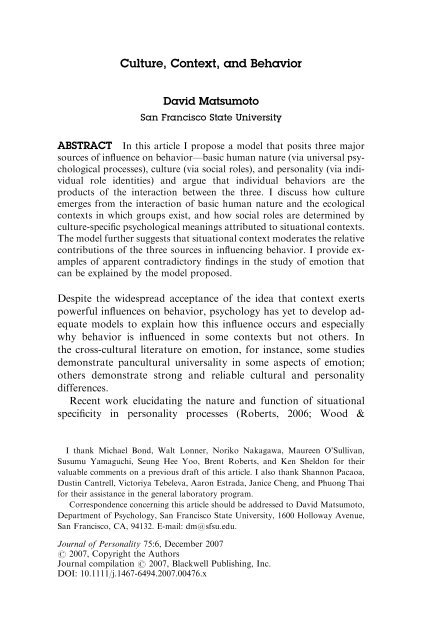
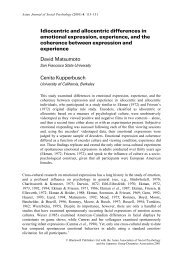
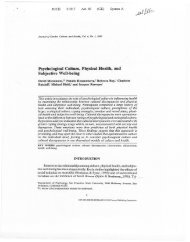
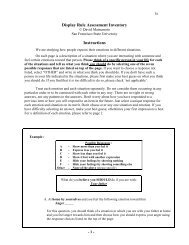
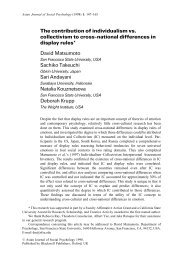
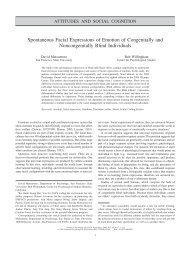
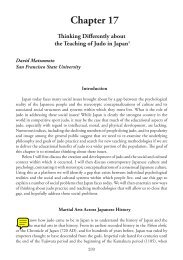
 Matsumoto, D., Yoo, S. H., & LeRoux, J. A. ... - David Matsumoto"
>
Matsumoto, D., Yoo, S. H., & LeRoux, J. A. ... - David Matsumoto"
>
